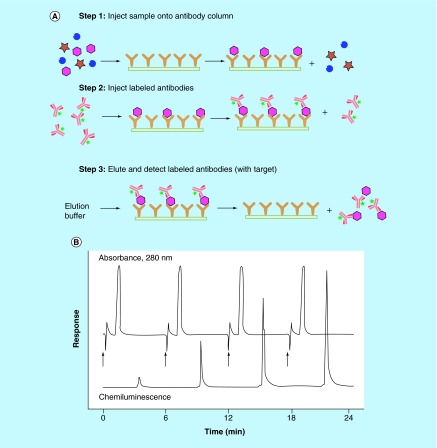Chromatographic Immunoassays & Immunoextraction
There a many possible applications for affinity-based techniques in chemical analysis. One area that our group has been studying for many years is the use of antibodies in HPLC systems. This has resulted in the creation of methods we refer to as “chromatographic immunoassays”.
Fig. General Scheme for Sandwich Immunoassay
These methods can be used for rapid and selective measurements of drugs, hormones, proteins, and peptides in biological samples. This makes this approach appealing for use in clinical testing, pharmaceutical analysis, and biotechnology. Chromatographic immunoassays can also be combined with other analytical methods, like reversed-phase HPLC or capillary electrophoresis, for the simultaneous analysis of several compounds within a given class of chemicals. We have published many papers on this topic and this work was the subject of a review and a cover article that appeared in an April 2001 issue of Analytical Chemistry.
One recent application of our work in this area has been the development of an automated, portable system for the determination of triazine herbicides in water. This method combines the use of a small antibody column with a traditional reversed-phase HPLC column and UV/vis absorbance detection. We have recently evaluated the use of this system in the field and have shown that it can be provide results at a site of a river or stream within 10 min of sample injection. This same method can be altered for measurement of other herbicides or pollutants by changing the type of antibody column that is used in the system.
Other examples of chromatographic immunoassays that have been developed by our group include techniques for L-thyroxine, parathyroid hormone, fluorescein-labeled proteins, and human serum albumin. We have explored and developed many assay formats in this work, including methods that make use of competitive binding assays, sandwich immunoassays, displacement immunoassays, and one-site immunometric assays. As part of these studies, our group has been one of the first to consider the theory of these methods. The result has been a series of equations and computer models that we have successfully developed to describe the response and behavior of these assays under various operating conditions.
Another example is to measure free drug/hormone fractions by using of an ultrafast immunoextraction/displacement assay. This method is based on using of sandwich microcolumns that contain a small layer of antibodies which bind the drug/hormone. Free fraction of drug/hormone can be extracted by this affinity column in very short periods of time (e.g., 80-120 ms). The free drug portion in the solution can be isolated when a drug-protein mixture passing through this type of column. The result is found to give good correlation with traditional methods like ultrafiltration but requires much less analysis time, makes this approach attractive for use in pharmacological studies and a tool in clinical chemistry for personalized medicine.
Examples of Research with Chromatographic Immunoassays and Immunoextraction
1.) Chenhua Zhang, Shae Lott, William Clarke and David S. Hage*, “Development of a Microcolumn One-Site Immunometric Assay for a Protein Biomarker: Analysis of Alpha1-Acid Glycoprotein in Serum”, J.Chromatogr. A, 1610 (2020) 460558.
2.) Elliott Rodriguez, Saumen Poddar, Meera Choksi, and David S. Hage*, “Development of an On-line Immunoextraction/Entrapment System for Protein Capture and Use in Drug Binding Studies by High-Performance Affinity Chromatography”, J. Chromatogr. B, 1136 (2020) 121812.
3.) Cong Bi, Ryan Matsuda, Chenhua Zhang, Zitha Isingizwe, William Clarke and David S. Hage*, “Studies of Drug Interactions with Alpha1-Acid Glycoprotein by Using On-line Immunoextraction and High-Performance Affinity Chromatography”, J. Chromatogr. A, 1519 (2017) 64-73.
4.)Erika L. Pfaunmiller, Jeanethe A. Anguizola, Mitchell L. Milanuk, NaTasha Carter, David S. Hage*, “Use of protein G microcolumns in chromatographic immunoassays: A comparison of competitive binding formats”, J. Chromatogr. B, 1021 (2016) 91-100.
5.) Erika L. Pfaunmiller, Cong Bi, Zhao Li, John Vargas-Badilla, Xiwei Zheng and David S. Hage*, “Immunoaffinity Chromatography”, In: Advances in Liquid Chromatography: New Developments in Stationary Phases and Supports for Drugs and Bioanalytical Applications, David S. Hage (Editor), Future Science, London, 2015, Chap. 5 (pp. 60-74).
6.) Ryan Matsuda, Elliott Rodriguez, D. Suresh, and David S. Hage*, “Chromatographic Immunoassays: Strategies and Recent Developments in the Analysis of Drugs and Biological Agents”, Bioanalysis, 7 (2015) 2947-2966.

